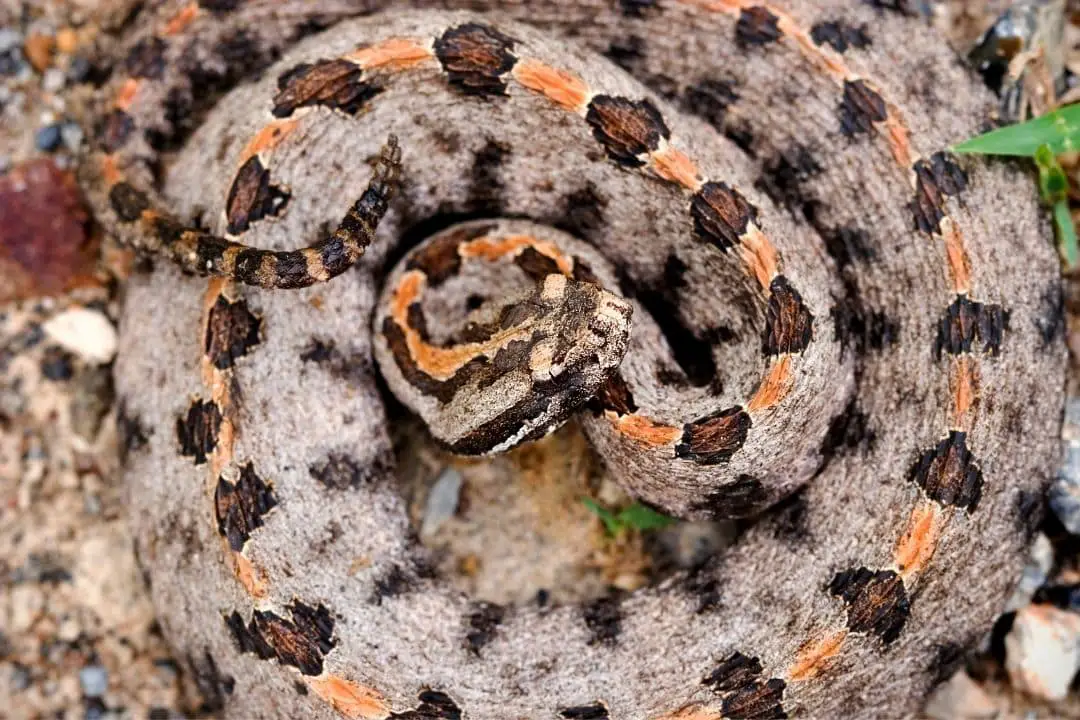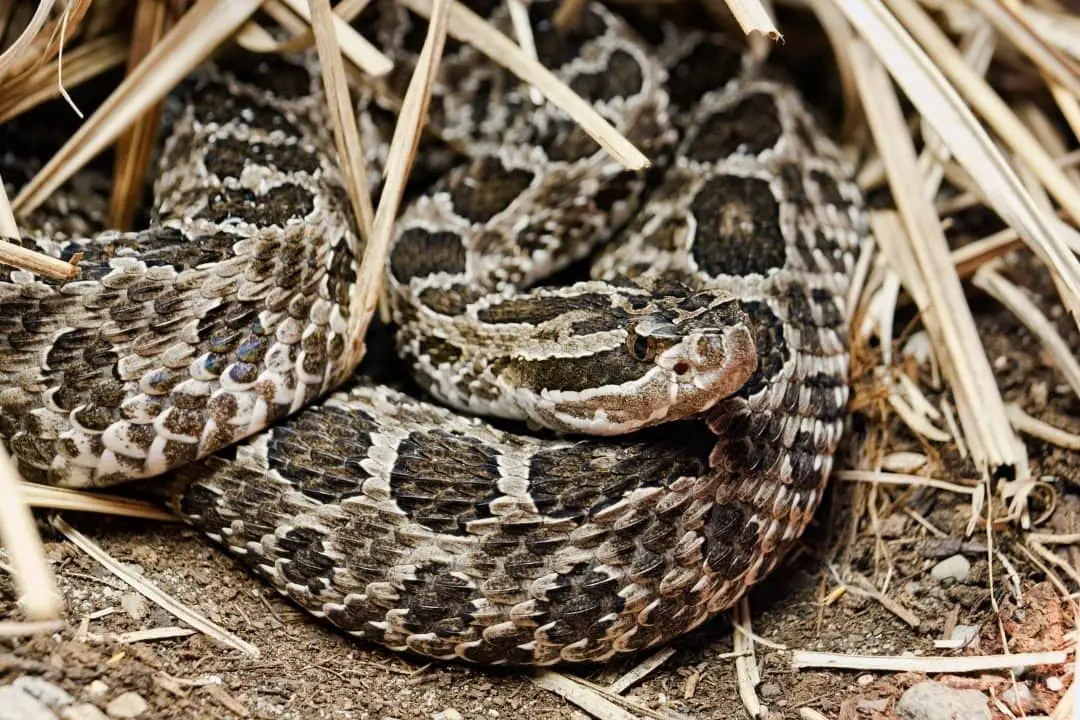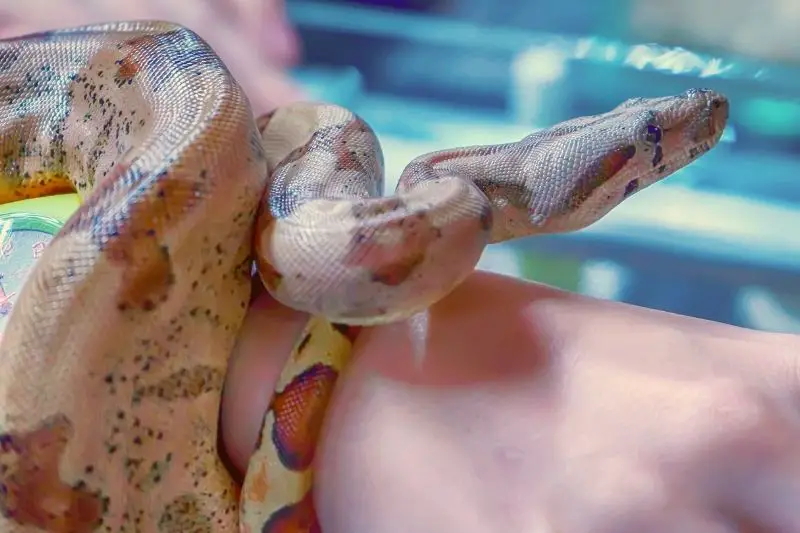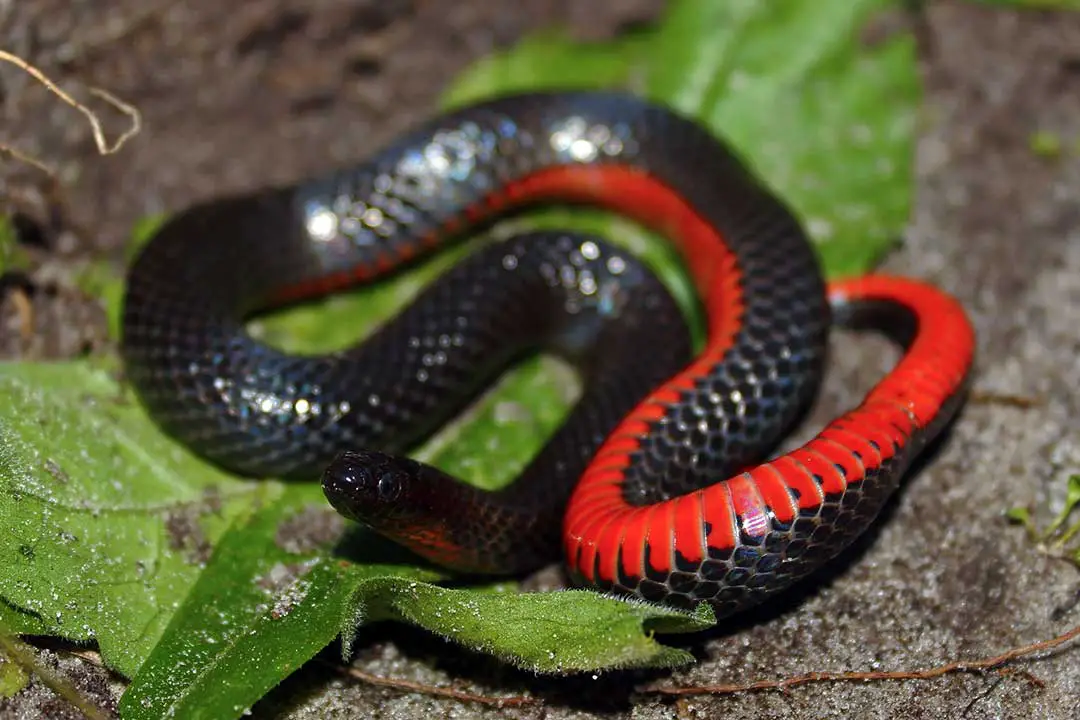Georgia is home to many species of snakes (full list of georgia snakes here). The vast majority are Nonvenomous or have venom that isn’t dangerous to humans.
There are snakes that can seriously harm or kill a human spread across the state.
This list will help you learn to identify these snakes and also lists what their venom does. Remember to always wear boots and long pants in any area with venomous snakes.
If you hear a venomous snake or run across one, stay still until you locate the snake and then back away. This will help prevent any bites.
1. Copperhead
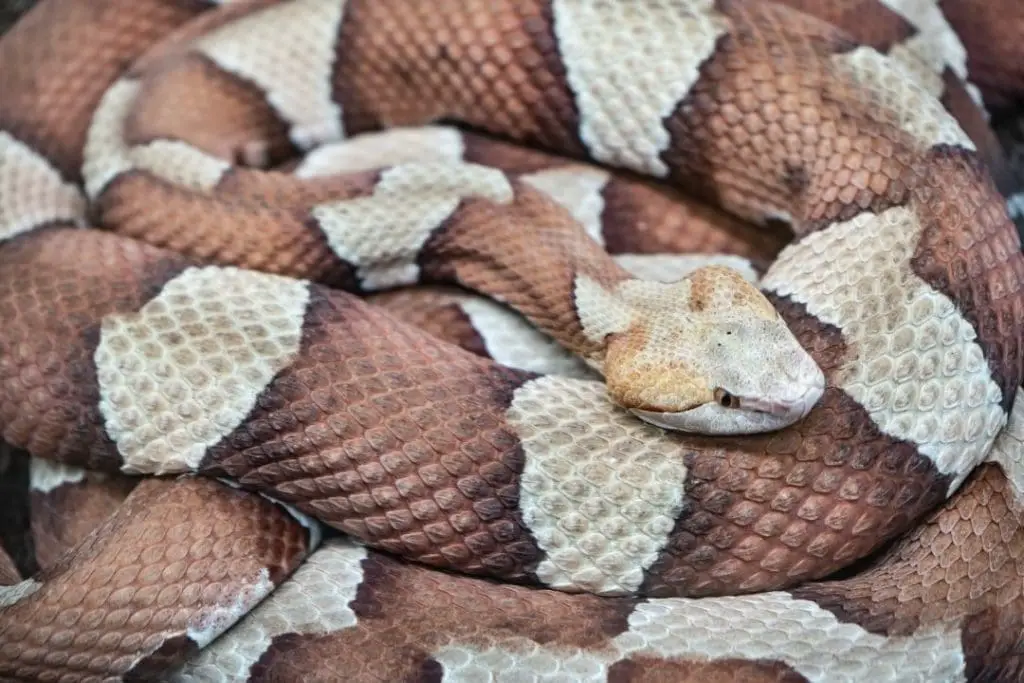
The copperhead (Agkistrodon contortrix) is a pit viper that stays between 20 and 37 inches long.
These snakes can be found over much of the state aside from the south-central area, so be careful.
They are named for their reddish-brown background color. They have hourglass-shaped bands across the body.
They have a wide head and elliptical pupils.
Juveniles look like adults but have a yellow tail tip. While other snakes in Georgia have a similar color, only the copperhead has hourglass-shaped banding.
They prefer dry rocky hillsides for habitat in the mountains and may den with the timber rattlesnake. They prefer hardwood forests and swamp margins closer to the coast.
They can be found in suburban areas that border these habitats since they tolerate habitat changes. They eat nearly any small animal they can catch.
Copperheads tend to deliver the least venom of the pit vipers.
They commonly give warning bites with little or no venom. The venom causes extreme pain, swelling, tingling, and nausea.
There can also be damage to bone and muscle depending on the location of the bite.
2. Eastern Diamondback Rattlesnake
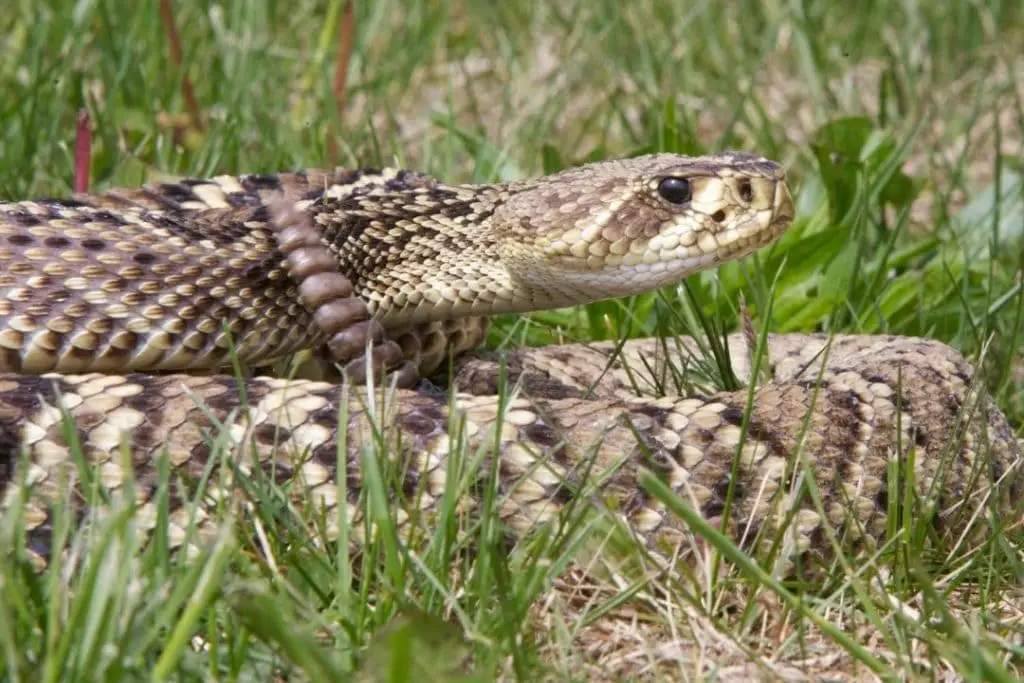
The Eastern diamondback rattlesnake (Crotalus adamanteus) is found mostly in the southern half of Georgia. These are the largest venomous snake in the state. They can be between 33 and 72 inches on average.
Some animals can get up to 96 inches long. They are heavy-bodied animals that can weigh up to 10 pounds.
They are brown, tan, or yellow with dark brown diamond markings that are bordered with lighter scales.
They are typically found in dry habitats like pine forests, palmetto thickets, and sand dunes but they will swim to reach new habitats.
They eat mainly mammals such as rabbits and spend their time in dense vegetation to ambush their prey. While they are not currently considered endangered, their populations are disappearing rapidly.
Some places in Georgia have rattlesnake roundups that have nearly wiped out the population.
Their snake bite and venom is very dangerous to humans and has a fatality rate of 10-20% without treatment. Bites to humans cause intense pain, bleeding, swelling, and death.
3. Timber Rattlesnake
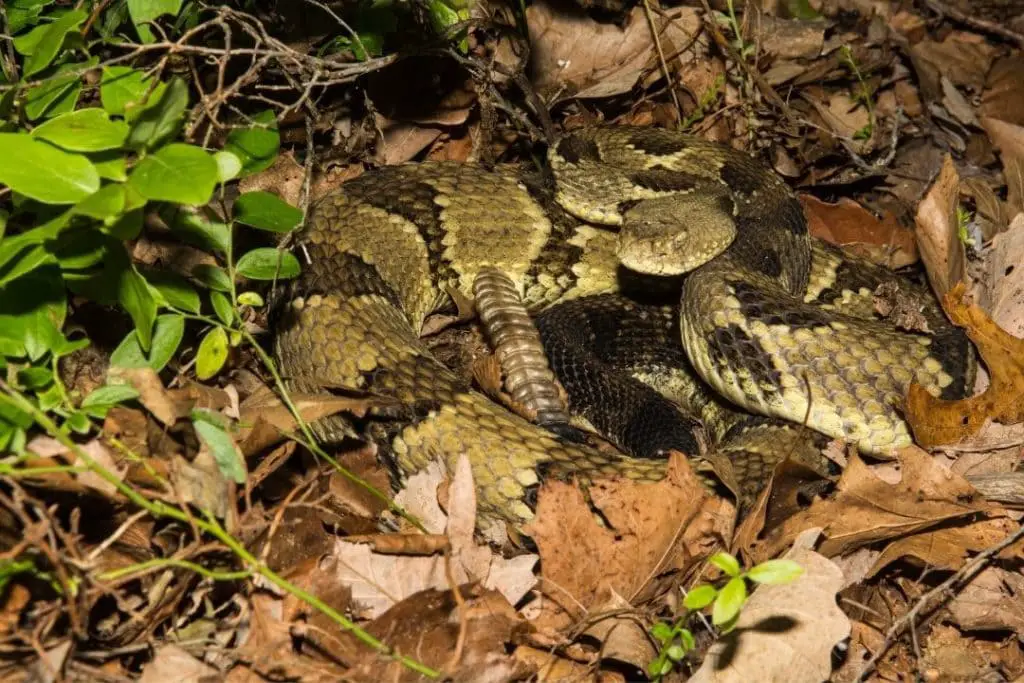
The timber rattlesnake (Crotalus horridus) is also called the canebreak rattlesnake on the coastal plains.
It is found throughout most of the state aside from a few small areas in the south of the state. They are between 30 and 60 inches long but some animals can get to 72 inches long.
The canebreak rattlesnake is gray with a pinkish hue with a pinkish, yellow, brown, or orange stripe running down the back. Timber rattlesnakes elsewhere are more brown or yellow and may even be black.
Both forms have black chevrons down the back and black tails. Males are typically larger than females. They live in a wide variety of habitats aside from heavily urbanized areas and housing developments.
They eat mainly small mammals but large individuals will eat rabbits. The exact venom depends on the location since four unique venom types have been found for the species.
The venom of snakes in the southern part of its range is typically neurotoxic, but it can vary. It is rare for these snakes to bite humans since they avoid humans and will only bite if very distressed.
4. Pigmy Rattlesnake
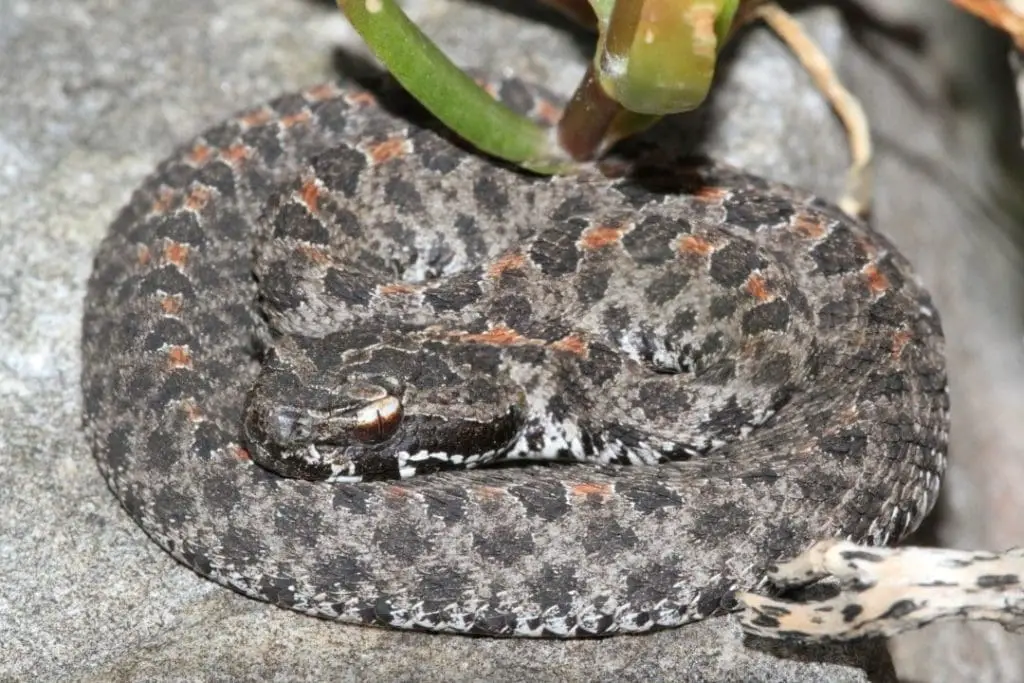
The pigmy rattlesnake (Sistrurus miliarius) is only 14-22 inches as adults.
They can be found over most of the state aside from the northern border. Since they have such a small rattle, they are rarely heard unlike the other rattlesnakes of Georgia.
There are two subspecies that can be found in the state, but they look very similar. These subspecies are the Carolina pigmy rattlesnake (S. m. miliarius) and the dusky pigmy rattler (S. m. barbouri).
The snake can be gray, tan, or lavender for the Carolina pigmy rattlesnake, but the dusky pigmy rattler can be darker. Some animals from the north of Georgia may be orange or red.
They typically have mid-dorsal spots and very defined patterns. Young snakes have a lighter tail that they use to lure prey. The Carolina subspecies are found in the northeast, northwest, and central portions of the state while the dusky subspecies can be found in the southern coastal plain.
The dusky subspecies tend to prefer wet habitats while the Carolina prefers drier areas.
Sometimes mistaken for rat snakes, they typically hide in leaf litter where they ambush small lizards, amphibians, mammals, and insects. Since they are small, they cannot kill adults.
Children may be at risk of hospitalizations. Snake bites are painful and damage cells. They can cause heavy bleeding and cause tissue damage.
5. Eastern Coral Snake
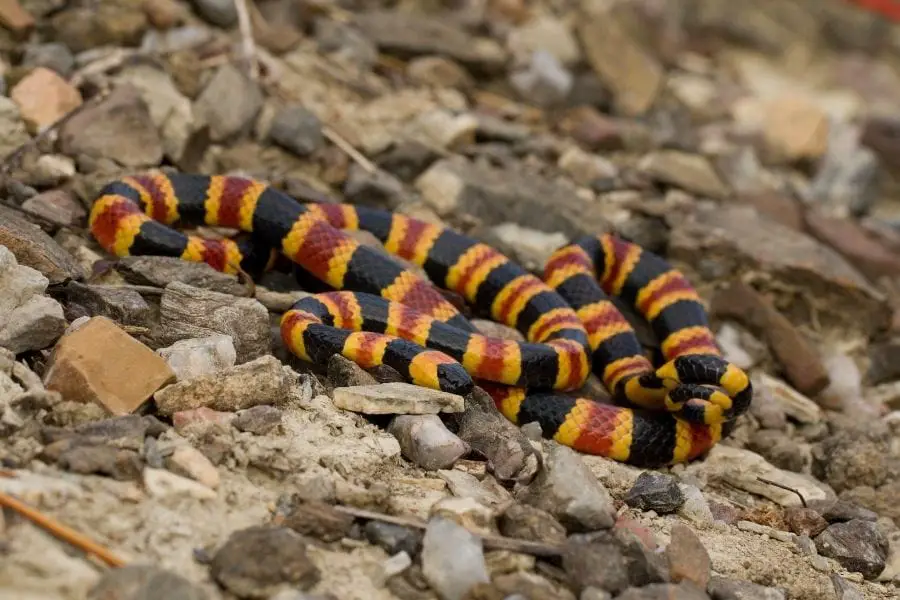
The eastern coral snake (Micrurus fulvius) is a colorful venomous snake.
They are between 14 and 30 inches long as adults and have very slender bodies. They can be found mainly in the south of the state.
They have smooth scales and have a banded body that is red, yellow, and black.
The easiest way to tell them apart from their non venomous snake species mimics is to remember that the red will touch yellow and its head is entirely black with a yellow ring around the neck.
Also see my article about how to tell if a snake is venomous.
Coral snakes snakes rarely seen since they stay underground and will rarely if ever climb trees. When disturbed, they will curl their tail.
Eastern coral snakes are typically found in dry and open areas with bushes but no heavy vegetation. They eat primarily snakes and lizards, but will also prey on frogs.
Humans bitten by this snake will experience slurred speech, double vision, muscle paralysis, and respiratory failure. Bites and fatalities are rare, but treatment should be sought immediately.
6. Northern Cottonmouth
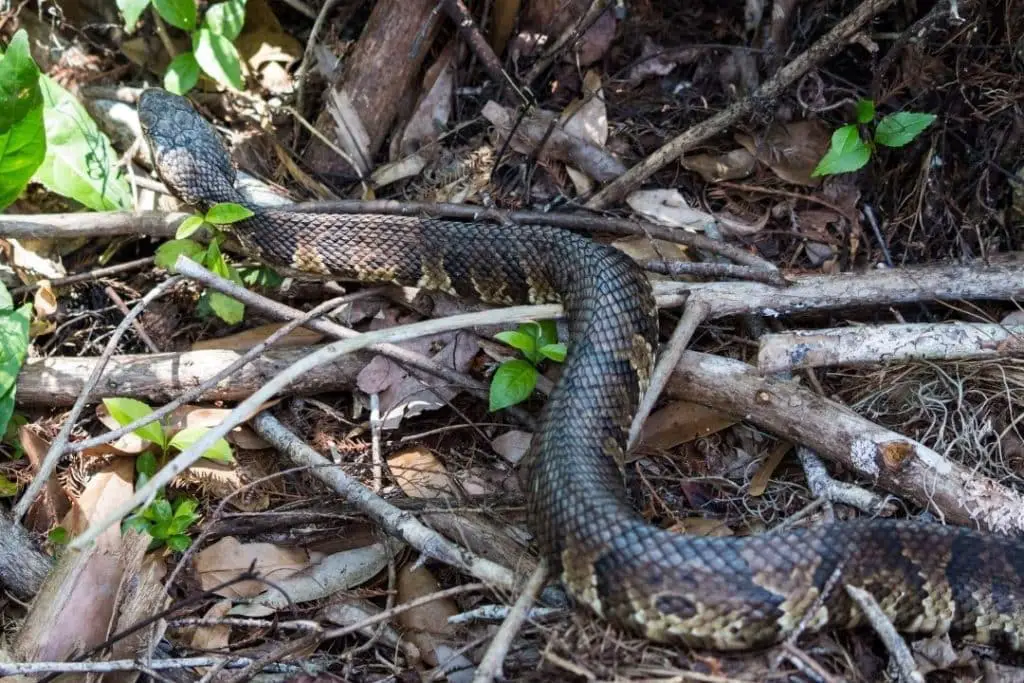
The Northern cottonmouth (Agkistrodon piscivorus) is found mainly in the central portion of Georgia.
These snakes are also commonly called water moccasins because they are frequently found by water or swimming. Adults are typically between 26 and 35 inches long.
The can be gray, brown, tan, olive, or black with black or dark brown cross bands along the body. Juveniles are lighter with high contrast markings. All ages have the white mouth that the snake will display when threatened.
This georgia water snake species prefers slow-moving or still bodies of water such as lakes, swamps, and sluggish streams. They can sometimes be found in moist habitats up to a mile away from water.
The bulk of their diet is made up of frogs and fish, but they eat nearly anything. Their venom is rarely fatal since it only causes systemic effects if the victim is allergic.
Their venom is cytotoxic and can cause heavy tissue damage. This can leave scars or may require amputation. They rarely bite unless handled.
7. Florida Cottonmouth
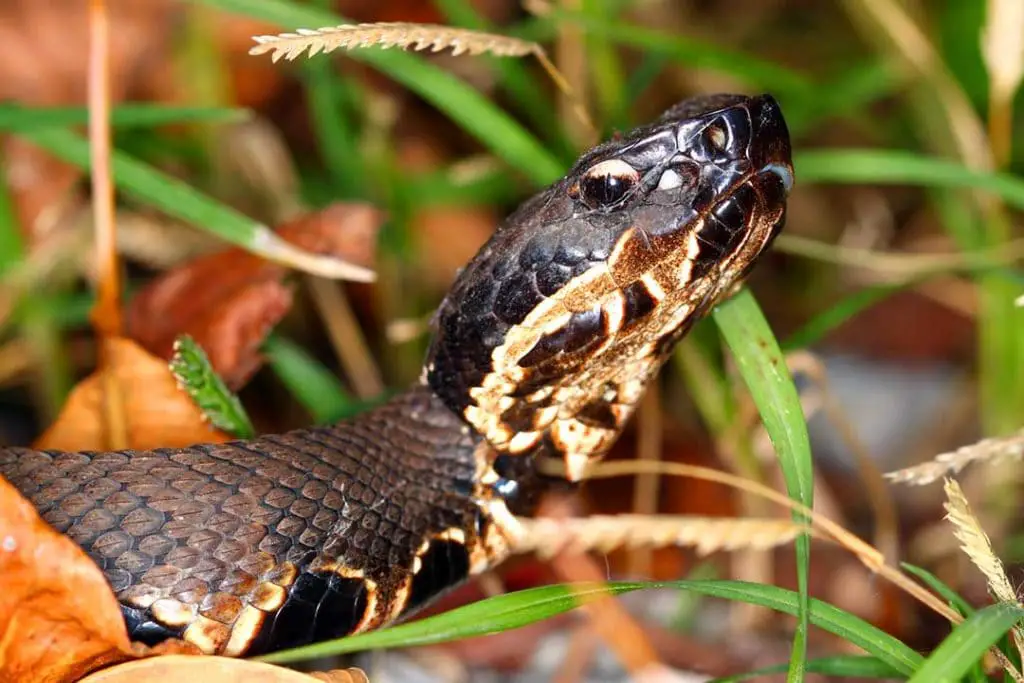
As the name implies, the Florida cottonmouth (Agkistrodon conanti) is mainly found in Florida.
However, it can be found in Georgia along the border. It was once considered a subspecies of the Northern cottonmouth, but it was separated to its own species in 2015.
The snake is brown, olive brown, or black with dark bands as an adult. Young snakes will be red and have more visible patterning.
The Florida cottonmouth can be told apart from the Northern cottonmouth by the difference in head markings and color. Florida cottonmouths have much lighter heads with high-contrast markings even as adults. The Florida cottonmouth also has two lines going over its snout that the Northern cottonmouth lacks.
They prefer living near water and frequent small bodies of water that are drying up in the summer. This is to allow them to hunt the aquatic prey that is concentrated when the water levels drop.
Like the Northern cottonmouth, they will gape as a threat display. They will also flatten their body, hiss, and produce a foul-smelling musk.
Their venom ruptures red blood cells and can cause necrosis around the bite. It has a higher fatality rate than many other snakes that hovers around 17% without treatment. They are unlikely to bite, but they will do so if threatened.
Conclusion

Georgia is fortunate in that its venomous snakes are docile and rarely cause fatalities.
However, their bites should always be treated even if you don’t see any symptoms.
Some venoms can take time to start showing any symptoms. It is best to respect venomous snakes and give them their space. While they are dangerous to humans, these animals want to stay very far away from you, just like non venomous snakes.
They only bite if they feel threatened. If you have any questions or comments, please leave them below.
